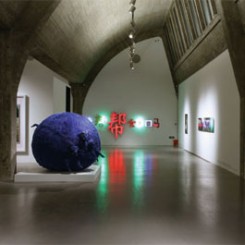Performance has never been an easy choice of artistic career. The urge to “perform” fulfils a different need from that inspired by other art forms, say, painting: it is a full physical immersion in art that—usually—requires the presence of an audience, or interaction with the immediacy of a time and place, to be completed as each artist envisions. Thus, it is not surprising that the development of performance art in China occurs at some of the most challenging times that artists have faced: in the late 1980s, as culture flowered under the radar of economic reforms; in tandem with social change and unrest that these reforms engendered through the 1990s; and against scientific developments in the late 1990s through the start of the new millennium. To choose this distinctly non-mainstream form of art in China, and as a response to particular moments, was never happenstance. To perform was to engage in a moment and effectively to leave no trace of anything that could be used against the individual artist at some point immediately after or in the future. But the need to document these actions and performances was soon felt, hence the significance of the work that photographer Rong Rong did in the 1990s recording the performance works of fellow members of Beijing’s East Village co-operative. These times were, as Rong Rong has described, “dark, dark, dark” (2). These artists were inevitably poor, marginalized, and living on the fringes of society. Their body was the only thing they could call their own, and the works they produced, therefore, have a far different intent, meaning, and resonance than other forms of expression—or even those performance works that followed them in the new millennium by which time all forms of contemporary art in China had achieved a degree of legitimacy and official acceptance. That is, of course, with the exception of performance art, which continues to struggle for validation in the public realm as the organisers of the 8th Shanghai Biennale 2010 would attest (3). According to one writer in an essay on Zhang Huan: “Nothing is more politically, socially, economically or culturally challenged than the free expression of the human body as an autonomous entity. For while we are all inclined to say ‘this is my body,’ the container of ‘my consciousness,’ the body is nonetheless historically hemmed in and determined by many culture-based and structural suppositions of distinction and dissonance” (4). It is hardly surprising therefore that performance art in China has always been presented to a privileged few. Even before an official edict prohibiting it (5), performance art in China was positively underground. Yet, since the inception of an “avant-garde” scene in the mid-1980s, performance has drawn some of China’s most dynamic, innovative and fearless artists.
The question is this: should we really be surprised to find performance art now entering the mainstream? Of course, looking back, 2010 was a good year for performance art. The obvious example is “The Artist is Present,” the solo exhibition of the world’s most famous living performance artist Marina Abramovic held at MoMA, New York. If anything can be said to have made performance art “safe” for general consumption, surely it is this landmark exhibition of a radical performance artist in a major mainstream museum. Billed as the first significant presentation of Abramovic’s art, “The Artist is Present” celebrated four decades of her career: a long road to “popular” recognition, which reflects the choice of positioning of Abramovic herself as an artist, and the general attitudes towards the particularly “extreme” form of performance art she was instrumental in pioneering—relevant here because this is the side of performance that has dominated performance art in China. Flick through the exhibition catalogue and you get an idea of the struggle artists faced in those early years of performance art and to sense the often shocking extremes to which many of them felt they had to go in order to get their message and their commitment across. Abramovic is a relevant example, too, since many of her works have a parallel in the shape, form, and content of those of Chinese performance artists, beginning with the East Village artists in the early 1990s to Sun Yuan and Peng Yu later on. That was inevitable at the time, where artists who wished to depart from the visible norms and to experiment with life itself drew confidence and a certain raison d’être from the work of pioneers such as Abramovic for everything from physical endurance, to placing the body/self in imminent danger, and to the use of live animals or dangerous props.
